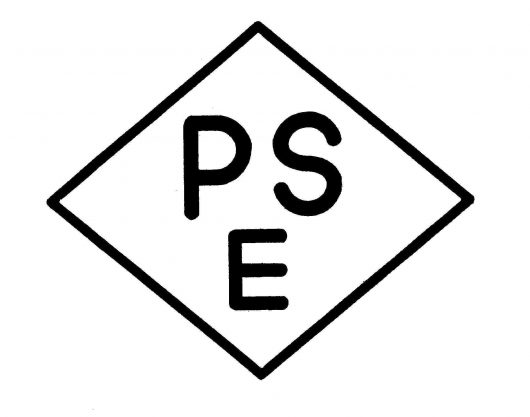Those who want to know about PSE of switching power supply
“I know PSE is a safety standard, but I’m not sure what it is in the first place.
Is there a switching power supply that is approved for PSE?
How can a switching power supply be PSE certified? ”
I will answer these questions.
As I write this article, I have actually had the experience of adapting switching power supplies to the PSE standard.
The power supply was a 100W board type power supply put in a case and the harness was taken out. The PSE certification cost was about 300,000 to 400,000 yen per model.
If you want a switching power supply to meet the PSE standard, what kind of power supply can meet the PSE standard? Is this right? If you are uneasy, please refer to it.
However, it is best to have an inspection agency confirm the delicate judgment.
Judgment may change depending on the inspection agency.
Telephone consultation with the inspection agency is free for the first 30 minutes.
When it comes to concrete things, the time runs out.
- What is PSE in the first place?
- Difference between “DC power supply” and “DC power supply unit for embedding equipment” of PSE
- DC power supply
- DC power supply unit for embedding equipment
What is PSE in the first place?
Formally, it is called the “Product Safety Electrical Appliance and Material”.
It is a law designed to prevent people from being injured by AC-input electrical appliances.
The Electrical Appliance and Material Safety Law is a law, so breaking the Electrical Appliance and Material Safety Law violates the law. There are no fines or imprisonment, but you may be issued an on-site inspection by the Ministry of Economy, Trade and Industry, an order for remedial measures, and an order to collect the product.
Electrical products subject to PSE cannot be sold without the “PSE mark” to the effect that they comply with national technical standards. It is the same when importing electrical products but selling them domestically.
There are the following two types of electrical equipment.
・Specified Electrical Appliances and Materials
“Specified Electrical Appliances and Materials” are electrical products with a relatively high risk, and the others are divided into “Non-Specified Electrical Appliances and Materials“. The electrical appliances below that we usually use at home are classified as “Non-Specified Electrical Appliances and Materials“.
Non-Specified Electrical Appliances and Materials
Source: Ministry of Economy, Trade and Industry (Electrical Appliance and Material Safety Law)
Non-specific electrical appliances (341 items) are general electrical appliances (dryers, hot plates, electric kotatsu, irons, etc.). It is a home appliance that we usually use. It is called “Round PSE” because of its mark.
In order to sell non-specific electrical products domestically, the seller is obliged to check for himself whether the product complies with PSE (self-declaration).
For example, when a Japanese importer imports “non-specific electrical products” from China and sells them in Japan, the PSE confirmation test is conducted at a factory in China, the PSE mark is attached, and the product is exported to Japan. Japanese importers must check the PSE test data to see if they comply with the PSE standard.
In addition, it is obligatory to keep the test data and submit it immediately when requested by the Ministry of Economy, Trade and Industry. Even if it is a self-declaration, the importer cannot sell non-specific electrical products domestically without doing anything.
Ministry of Economy, Trade and Industry / Enforcement of the revised government ordinance of the Electrical Appliance and Material Safety Law
In fact, it turned out that there was no test data for 80 Round PSE electrical products made by KONAN in China in 2014, and it was recalled for product recall and is still being recalled. The reason is that there is no inspection record and it seems that the importer, KONAN, did not confirm it. However, I think it would be better to check the test later, but of course it is not legal after domestic sales.
Important notice for recall products of KONAN Shoji
Specified Electrical Appliances and Materials
Source: Ministry of Economy, Trade and Industry (Electrical Appliance and Material Safety Act)
Specified Electrical Appliances and Materials (116 items) are high-risk products (electric wires, fuses, switches, vending machines, washlets, massage machines, etc.) and are called “Diamond PSE” from the mark. Among them is the “DC power supply“.
This PSE cannot be tested and confirmed by yourself, and inspection by an inspection agency is obligatory.
An inspection agency is an inspection agency registered with the Ministry of Economy, Trade and Industry. There are 7 companies in Japan such as incorporated associations and joint-stock companies
Difference between “DC power supply” and “DC power supply unit for embedding equipment” of PSE
First, I will explain the DC power supply.
DC power supply
There is a “DC power supply” in PSE specific electrical equipment.
However, few general switching power supplies are PSE compliant. Why? Isn’t the switching power supply a “DC power supply”?
Since PSE regulates final products (finished products), products incorporated into equipment are treated as “parts”, and general switching power supplies are not regulated by PSE.
In the first place, switching power supplies are rarely used by themselves and are made on the assumption that they will be incorporated into devices and equipment. Evidence of this is that switching power supplies are mounted on a single board or on a chassis with screw holes for mounting to devices and equipment.
A PSE-regulated product, a “DC power supply,” is a single power supply that is sold as a final product in the market. A typical product is a PSE-regulated product because AC adapters for laptop computers and game consoles are used externally and can be bought and sold by the power supply alone. By the way, the AC adapter has a diamond-shaped PSE mark.
DC power supply unit for embedding equipment
The PSE has a power supply called a “power supply unit for embedding equipment“.
Inquiries about whether switching power supplies are subject to PSE or not are increasing, and in 2015, the Ministry of Economy, Trade and Industry notified that general switching power supplies are not PSE-targeted products as “DC power supply units for embedding equipment”. Did.
The Ministry of Economy, Trade and Industry’s “DC power supply unit for embedding equipment” can be summarized as one of the following power supplies. Most common switching power supplies meet this requirement and are not subject to PSE.
①Board type switching power supply
It is a switching power supply for a general board alone. There are connector and terminal block types for input and output. Certainly, the board type cannot be used unless it is incorporated into the device.
②Board-type power supply with chassis and unit power supply
It is a type with a chassis (L sheet metal) attached to the upper board type power supply. In PSE, the chassis is called a “bracket”. The bracket makes it easier to attach to the device.
The unit type power supply is originally equipped with a chassis (without cover).
③Unit power supply with input terminal block cover
A cover is attached to the unit power supply, and the input unit is a terminal block type. Generally, the unit power supply has many input / output terminal blocks.
④Board-type power supply with chassis cover for output connector
It is a board type power supply with a chassis and a cover attached, and the output is a connector type. Generally, for board type power supplies, connectors are the mainstream for input and output.
In summary, the board type power supply and unit power supply are all “DC power supply units for embedding equipment” regardless of whether the chassis cover is removed or attached, and are not subject to PSE.
On the other hand, switching power supplies that do not meet the above conditions ① to ④ are PSE-targeted “DC power supplies.” In other words, it is a board type power supply or a unit type power supply covered with a chassis and a cover, and either the input or output is a cable (harness).
An easy-to-understand example is the SPLFA series made by Cosel. This is a PSE-targeted “DC power supply” of the LFA series of board-type power supplies. The SPLFA series has been discontinued.
Advantages of conforming to PSE standards for switching power supplies
The switching power supply may be PSE compliant. What are the benefits of getting a PSE?
The device (equipment) side is no longer a PSE target product
That is, the equipment / equipment body after the power supply becomes a DC input and is not subject to PSE regulation. As I wrote at the beginning, PSE targets AC input electrical appliances, so DC input products are not covered in the first place.
For reference, the Ministry of Economy, Trade and Industry notified on April 2, 2012 in 1- (3) of “Interpretation of the range of electrical appliances, etc.” as follows.
In other words, if the power supply is PSE-compliant and placed outside the device, the device side in the subsequent stage will not be subject to PSE, and the cost and time required to conform to PSE for the entire device can be significantly saved. That is why a PSE-compliant power supply is placed outside the device rather than a built-in power supply inside the device.
However, it is not enough to just place the power supply outside the device, and the condition is that the power supply and the device housing can be easily removed with a connector or the like. Even if the power supply is placed outside the device, “If it cannot be easily removed, it is treated as an integrated device and is subject to PSE regulation by the device name. If it cannot be easily removed, it may be crimped with a crimp terminal. If it is soldered.
Certainly, the PC and AC adapter can be easily removed, so there is no PSE mark on the PC.
On the other hand, if the switching power supply is built into the device, the PSE will be acquired for the entire device. Since the power supply itself is built-in, it is not subject to PSE (DC power supply unit for embedding equipment), but the question is which PSE technical standard the switching power supply complies with. There are two technical standards for PSE “DC power supply”, “Appendix 8” and “Appendix 12”, and which technical standard does the switching power supply comply with? Or the question is whether it does not comply with either. If you do not comply with either, you will not be able to obtain PSE for the entire device.
As a noise countermeasure
Placing the power supply (AC adapter) outside the device prevents the AC AC voltage of 100V / 200V from entering the device. Since only a low-voltage DC power supply can be turned on inside the device / device, it is quite effective as a noise countermeasure.
However, the AC adapter is inferior to the switching power supply in terms of capacity (W), reliability, life, and performance. In addition, it is not suitable for small-lot, high-mix products because it will not be cheap unless the number of units is settled.
There are some points that the inspection agency sees when acquiring PSE at the end.
I mainly look at the following two points.
・Internal temperature of the power supply
Recommended PSE compatible switching power supply
TDK-Lambda ELV / ELC series
● Constant current control type (ELC) and constant voltage control type (ELV) are available in the same package.
● Wire pull-out type with a shape that is easy to mount in narrow spaces such as signboards
● IP66 standard (dustproof / splashproof) compatible
● IEC61000-3-2 Class C compliant (harmonic standard for lighting equipment) * Compatible with ELC50, 90 / ELV60, 90
● Compliant with PSE (Electrical Appliance and Material Safety Law Appendix 8 and 10) standards
This is the end of the article.
Thank you for reading.


